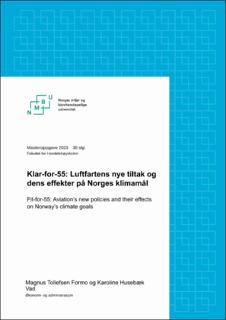| dc.contributor.advisor | Kine Josefine Aurland-Bredsen | |
| dc.contributor.author | Vad, Karoline Husebæk | |
| dc.contributor.author | Formo, Magnus Tollefsen | |
| dc.date.accessioned | 2023-07-14T16:27:37Z | |
| dc.date.available | 2023-07-14T16:27:37Z | |
| dc.date.issued | 2023 | |
| dc.identifier | no.nmbu:wiseflow:6839595:54592509 | |
| dc.identifier.uri | https://hdl.handle.net/11250/3078975 | |
| dc.description.abstract | Denne masteroppgaven tar for seg de potensielle effektene av de nye tiltakene for luftfarten, lagt frem i Klar-for-55. Klimagassutslipp og reduksjonene av utslippene blir stadig omdiskutert, hvor EU-kommisjonen i juli 2021 kom frem med en omfattende tiltakspakke Klar-for-55. Reduksjon av klimagassutslipp i transportsektoren er en sentral del av det grønne skiftet, og mer bærekraftig luftfart vil være en viktig del av dette. Både innovasjon og utslippsreduksjon vil være viktig i en grønn fremtid, kanskje spesielt for luftfartssektoren. Klimatiltak som retter seg mot både teknologisk utvikling og utslippsreduksjon anses derfor som spesielt viktig dersom luftfartssektoren skal være levedyktig i lavutslippssamfunn.
I denne masteroppgaven skal vi forsøke å se på hvilke effekter, Klar-for-55 tiltakene for luftfarten kan ha for oppnåelsen av Norges klimamål. Oppgaven begynner med en gjennomgang av dagens situasjon, før det gis nødvendig bakgrunnsinformasjon for videre analyser og drøftelser. For å gi økt forståelse av analysen og dens resultater, vil vi også gå gjennom relevant teori og tidligere litteratur på fagfeltet.
Videre har vi analysert og diskutert funnene i lys av teori og litteratur. Vi har valgt å anvende en samfunnsøkonomisk modell, der vi har tatt utgangspunkt i fire ulike scenarioer for å undersøke problemstillingen. Vi utfører analysen trinnvis, der vi tar for oss et scenario om gangen, før vi diskuterer effekten tiltakene vil på teknologisk utvikling.
Oppgaven har vist oss at samtlige tiltak som omhandler luftfarten bidrar til utslippsreduksjon og innovasjon. Tiltakene er imidlertid avhengig av både kortsiktig og langsiktig teknologisk utvikling, noe de er med å bidra til. Dette tyder på at implementeringen av tiltakene i Klar-for-55 er en gunstig strategi for å redusere luftfartens miljøpåvirkning og videre bidra til å oppfylle Norges klimamål. Som følge av dette konkluderer vi med at sektorene i Norge er avhengig av hverandre for at klimamålene skal oppnås. | |
| dc.description.abstract | This master’s thesis examines the potential effects of the new policies for aviation, presented in Fit-for-55. Greenhouse gas emissions and the reductions of emissions are constantly debated, with the European Commission in July 2021 coming up with a comprehensive package of policies Fit-for-55. Reduction of greenhouse gas emissions in sectors is a central part of the green shift, and more sustainable aviation will be important climate policies. Both innovation and emission reduction will be important in a green future, perhaps especially for the aviation sector. Climate policies aimed at both technological development and emission reduction are therefore considered particularly important if the aviation sector is to be viable in low-emission societies.
In this master’s thesis, we will try to see what effects Fit-for-55 policies for aviation can have on the achievement of Norway’s climate goals. The thesis begins with a review of the current situation, before providing the necessary background information for further analysis and discussions. In order to provide greater understanding of the analysis and its results, we will also go through relevant theory and previous literature in the field.
Furthermore, we have analyzed and discussed the findings in light of theory and literature. We have chosen to use an economic model, where we made four different scenarios to examine the issue. We carry out the analysis step by step, where we consider one scenario at a time, before discussing the effect the policies will have on technical development.
The master’s thesis has shown us that all policies relating to aviation contribute to emission reduction and innovation. However, the policies are dependent on both short-term and long-term technological development, which they help to contribute to. This suggests that the implementation of the measures in Fit-for-55 is a favorable strategy for reducing aviation’s environmental impact and further contributing to meeting Norway’s climate goals. As a result, we conclude that the sectors in Norway are dependent on each other for the climate goals to be achieved. | |
| dc.language | nob | |
| dc.publisher | Norwegian University of Life Sciences | |
| dc.title | Klar-for-55: Luftfartens nye tiltak og dens effekter på Norges klimamål | |
| dc.type | Master thesis | |
